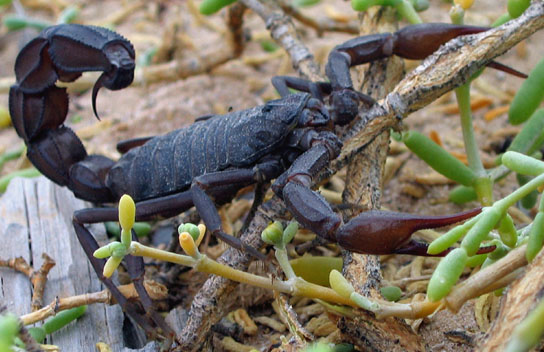- Fattail scorpion
Taxobox
name = Fat-tailed scorpion

image_width = 300px
image_caption = Arabian fat-tailed scorpion, "Androctonus crassicauda"
regnum =Animal ia
phylum =Arthropod a
subphylum =Chelicerata
classis =Arachnid a
ordo =Scorpion es
familia =Buthidae
genus = "Androctonus"
genus_authority = Ehrenberg, 1828
subdivision_ranks = Species
subdivision = 13 species, see article.Fattail scorpion or fat-tailed scorpion is the common name given to
scorpion s of thegenus "Androctonus", which is one of the most dangerous groups of scorpionspecies in the world. They are found throughout the semi-arid and arid regions of theMiddle-East andAfrica . They are a moderate sized scorpion, attaining lengths of 10 cm (just under 4 in). Their name is derived from their distinctly fat metasoma, or tail. Their venom contains powerfulneurotoxin s and is especially potent. Stings from "Androctonus" species are known to cause several human deaths each year. The German pharmaceutical company Twyford manufactures anantivenin for treatment of "Androctonus" and two closely related genera, "Buthus ", and "Leiurus ", envenomations. [http://www.toxinfo.org/antivenoms/productinfo/SCORPION_ANTIVENOM_TWYFORD_(NORTH_AFRICA)_A_081.html]Geographic range
Androctonus is widespread in the
Middle East andNorth Africa . Countries where "Androctonus" species live include:Mauritania ,Algeria ,Tunisia ,Libya ,Israel ,Egypt ,Jordan ,Saudi Arabia ,Yemen ,United Arab Emirates ,Kuwait ,Iraq ,Iran ,Pakistan , South Eastern Africa.Etymology
A rough English translation of the name "Androctonus" is "man-killer", from the Greek "andras" (άνδρας), meaning "man" and "kteinein" (κτείνειν), meaning "killing". "Crassicauda" means fat-tailed, from the
Latin "crassus" meaning "thick" or "fat" and "cauda", meaning "tail". Androctonus crassicauda is wide-spread throughout the middle east and its name means "fat-tailed man-killer". Similarly, the Latin word for South is "australis", from which "Androctonus australis", "southern man-killer", derives.Taxonomy
Taxonomic reclassification is ongoing, sources tend to disagree on the number of species.
*"
Androctonus amoreuxi " (Audouin, 1826)
*"Androctonus australis " (Linnaeus, 1758)
*"Androctonus baluchicus " (Pocock, 1900)
*"Androctonus bicolor " (Ehrenberg, 1828)
*"Androctonus crassicauda " (Olivier, 1807)
*"Androctonus dekeyseri " (Lourenço, 2005)
*"Androctonus finitimus " (Pocock, 1897)
*"Androctonus gonneti " (Vachon, 1948)
*"Androctonus hoggarensis " (Pallary, 1929)
*"Androctonus liouvillei " (Pallary, 1924)
*"Androctonus maelfaiti " (Lourenço, 2005)
*"Androctonus mauritanicus " (Pocock, 1902)
*"Androctonus sergenti " (Vachon, 1948)In Captivity
Despite the inherent risks with keeping such a dangerously venomous species in captivity, "Androctonus" scorpions are frequently found in the exotic animal trade - "A. amoreuxi" and "A. australis" being the most commonly available. As with any dangerous scorpion, a potential Androctonus keeper should think very carefully before acquiring one because a sting may have serious consequences which extend beyond the immediate risks of injury or death. For example, there can be an expensive bill for emergency medical care that the owner's
health insurance may not entirely cover. There is also potentiallegal liability if someone other than the owner is stung andnegligence can be proven. Depending on the jurisdiction in which the keeper lives, some form of licence or insurance policy may be required in order to possess a dangerous scorpion. In some jurisdictions, possession of a dangerous scorpion is illegal. Extra precautions must be taken to ensure that the scorpion cannot escape. Clearly, Androctonus scorpions should never be handled under any circumstances. Its main diet in captivity consists of cockroaches, grasshoppers, orcrickets . Scorpions will generally try to kill and eat anything which moves and is smaller than themselves. In order to simulate the desert environment, the enclosure used to keep the scorpion in must be kept at a temperature of between 26 and 30 degreesCelsius .In popular culture
The vicious mutated scorpions infesting the fictional English towns of Long Point and Port Pendall in
Michael R. Linaker 's horror novels "Scorpion" and "Scorpion: Second Generation" are said to belong to the "A. Australis" species. (^Published by New English Library, ISBN 0-450-05363-6)References
* [http://www.ub.ntnu.no/scorpion-files/buthidae.php The Scorpion Files: Buthidae]
* [http://www.ub.ntnu.no/scorpion-files/a_crassicauda_kuwait.php Photo of Androctonus habitat in Kuwait]
* [http://www.emedicine.com/med/topic2081.htm Treatment of Androctonus stings] ateMedicine
* [http://www.tparazitolderg.org/text.php3?id=194 Treatment of Androctonus stings]
Wikimedia Foundation. 2010.
